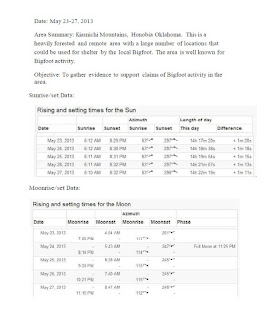I was going to discuss how to find research areas, but I will hold off on that as it's own separate article.
Randy Savig wrote an excellent article last week about why you should go on an expedition, I would recommend you read that article too.
Let's discuss how to plan for an expedition for your group now. For the MABRC, it's a lengthy process that begins with setting a date for the expedition and the location. This is usually done several months in advance so that people can begin making plans to attend and begin putting the resources together to be used on an expedition. There is also two different types of expeditions that the MABRC holds, one is the general expedition, where everyone that wants to attend may. The other is the specialized expedition, in which, those members with special skill-sets are asked to go along and not opened to the general membership.
Always remember the following!!
MABRC expeditions on the whole, usually consist of from 10 to 25 people, and the detail that goes into planning an expedition ensures that the expedition goes smoothly, and that anyone can step up and take the lead knowing what the overall plan is.
Let's walk through the process.
A MABRC member wants to have an expedition in one of their research sites. By default, they are now the expedition leader unless they ask someone else to be the leader. They then post on the MABRC Message boards in the Expedition Planning area that they want to hold an expedition along with the preferred date for it.
Other MABRC members then post whether they can attend or not, and an idea is put together how many will be attending.
Now the planning can be done, based on perspective numbers of attendees.
An Expedition Briefing Summary is then put together to distribute to all who will be attending, including those independent researchers and members of other groups who are invited to attend.
What does the Expedition Briefing Summary contain?
- Summary of the area
- Summary of the objective
- Sunrise/set data
- Moonrise/set data
- Moon phase data
- Weather outlook, must be updated starting 10 days prior to the expedition from weather.com and must be posted on the forum thread for the expedition planning.
- Site selection
- Background information for area, including any suspected Bigfoot activity.
- Topo maps/aerial photos of the target area.
- Primary objectives
- Secondary objectives
- Standby objectives
- Personnel requirements/skill sets needed along with role determinations for participants.
- Equipment requirements
- Expedition rules/land-owner rules.
Shown below is an expedition summary from Memorial Day 2013, as an example.
As you can see, it's better to contain too much information than not enough. With this information, anyone in the group can step up and lead the expedition should the expedition leader get injured or is unavailable for whatever reason.
Within 10 days of the expedition, weather updates begin to be posted on the expedition planning thread, this gives the members of the expedition enough advance warning to pack the type of gear they will need. For example, if rain is in the forecast, members can pack rain gear, bring tarps to hang up over the common areas where people will be sitting, and also to bring protective coverings for their equipment.
If the expedition is going to be a large one, with people coming in from different states, the MABRC will have an online meeting where they will discuss the expedition. Some of the slides below show parts of a meeting.
As some will note, we cover over in more detail about the Briefing Summary, and discuss between all the attendees. This is a good time for attendees to also bring forward anything they would like to try while on the expedition.
Once the whole plan is in place, we always refer back to Murphy's Law.
No matter the amount of planning will ever take into account every situation, but it will give you an edge and let you adapt and overcome most situations if you have a basic game plan in sight.
Most folks who have served in the real military, (Sorry Air Force :) ) you know that most plans go out the window when the first shot is fired. It's always safe to assume that this is true for Bigfoot Expeditions. Just be able to adapt to the situations, but always try to stay true to the original plan.
One main rule that I have as the Executive Director of the MABRC, is that when I plan an expedition, I am always the first in, last out, sometimes there will be members who beat me there, or stay longer, but they know that it's on them when they are there without me.
Once the expedition is on-site, copies of the briefing summary are available for anyone who wants one, (usually most folks will print it out before arriving and bring it with them.) and maps of the overall area are where they can be viewed.
The MABRC also maintains a strict Zero-Trace policy where we make sure to pack out all of our trash, and return the camp area back to it's original state as much as possible.
I hope that this helps someone out on planning their own expeditions. The MABRC has held over a hundred plus expeditions, not counting specialized expeditions, and this has worked for us many times over.

























This is a good read. Some very well put information. Thank you for writing this.
ReplyDelete